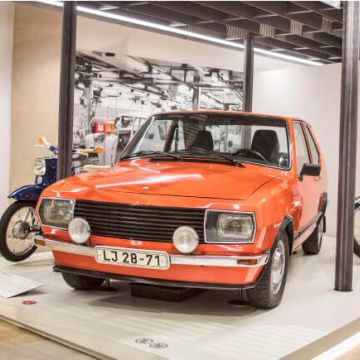In the last 200 years, ground-breaking inventions in road transport have enabled increasing numbers of people to travel the world. This exhibition presents the pioneers of this field, trailblazing bicycles, motorbikes and automobiles, and looks at how changes in road transport have had an impact on our everyday lives.
Hoofs, wheels and tyres – permanent exhibition on road transport

-
Until the invention of the “dandy horse” by Karl Drais some 200 years ago, people could only get as far as their own feet or horses would carry them. And when Carl Benz and his patented motor vehicle clattered through Mannheim around 70 years later, the scene was set for individual mobility.


-
As you wander through the exhibition, admiring our superb examples of two- and four-wheel vehicles (made predominantly in eastern Germany), you will realise just how far road transport has come since then. Trace the past, present and future of road transport by hopping on the penny farthing, immersing yourself in the future lab or sampling the sounds of transport at the audio stations.

-
Gläser Karosserie in Dresden
Gläser Karosserie GmbH in Dresden was one of the best-known coachbuilders in the 1920s and 1930s and made bespoke bodies for luxury cars by Horch, Audi and Mercedes, among others. A section of the exhibition is dedicated to this since-forgotten company with several large exhibits including a Röhr 8 Type F and an IFA F 8 model. The highlight is a newly restored NSU-Fiat 1100 from 1938 with an unusual display: While one half shows the completely restored car body, the other half is open and offers a glimpse into the vehicle’s interior, revealing hidden aspects of the body construction. The exhibition is completed with an overview of Saxon car makers between 1918 and 1933, demonstrating that Saxony was a cradle of automobile production.

Source: DresdenEins
Find the exhibition here:

More exhibitions
-
Railway transport
moreThe invention of the railway made life as we know it possible. This exhibition illustrates the important stages in Saxon and German railway history, from its early days right up to the modern age, showcasing a host of valuable original components and models.
-
Navigation
moreHow have people, past and present, lived and worked on and by the water? Our permanent exhibition on navigation brings 1,000 years of ocean and inland shipping history vividly to life.
-
Aviation
moreFlying: once a perilous feat of daring, now an everyday occurrence. Our exhibition on the history of aviation pays tribute to those courageous pioneers and their high-flying adventures, with a special focus on aircraft construction in the German Democratic Republic.
-
Model railway
more225 locomotives and carriages, 785 metres of track, five stations: Our elaborate model train set lets visitors lose themselves in a lovingly crafted miniature world.






